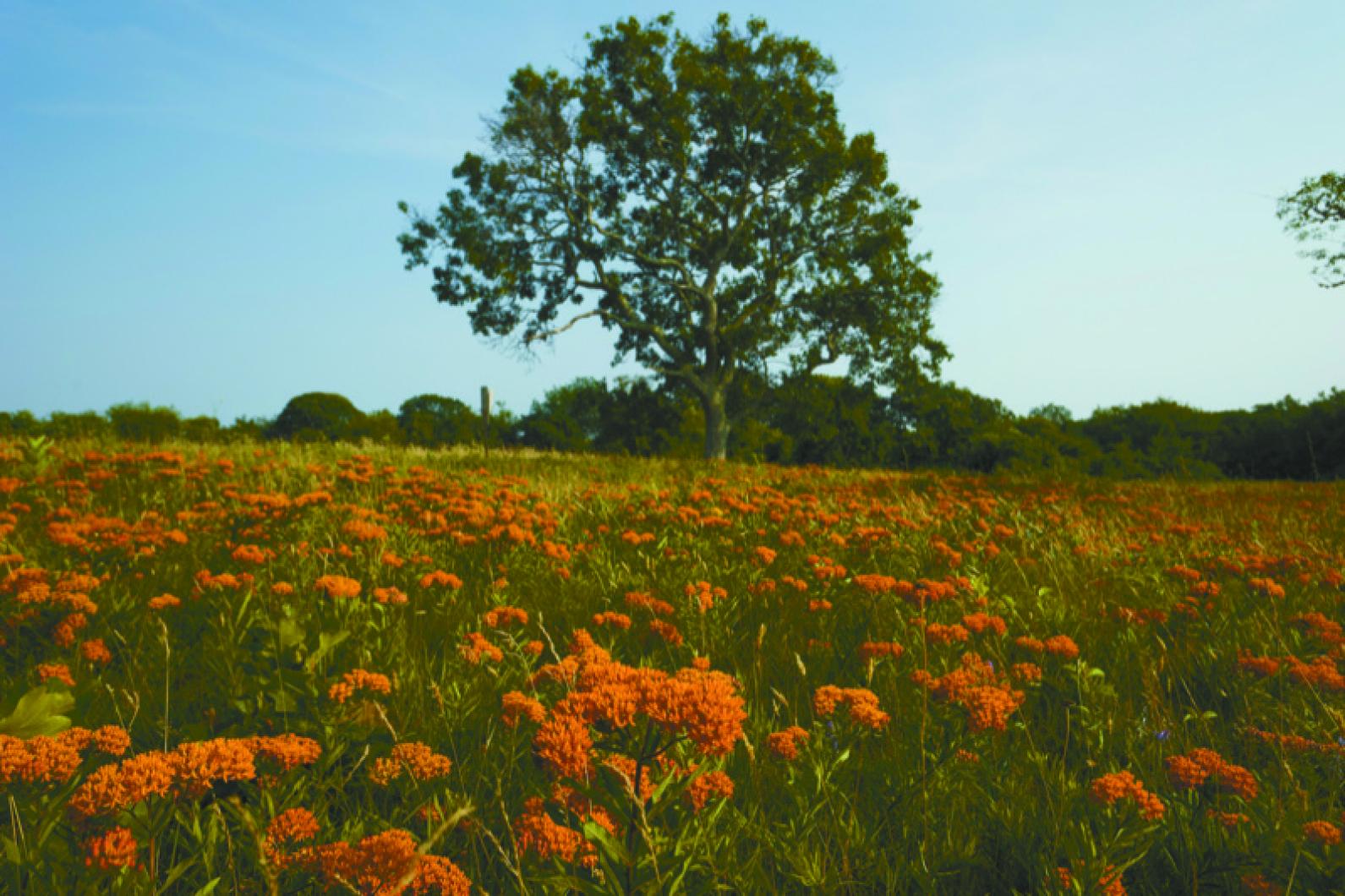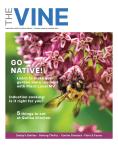Whether you see the landscapes of the Vineyard every day or dream about them from afar, one thing is certain — the Island is uniquely beautiful and retains a special, ecological character that many other places have lost. This lasting, natural beauty is due in large part to the native plants that have flourished here, evolving in our landscape for thousands of years. But more and more commonly, invasive, nonnative species are threatening to take over, presenting a danger not only to the look and feel of the Island but also to the countless creatures that call it home.
NATIVE, NONNATIVE, INVASIVE: WHAT’S THE BIG DEAL?
When you think about your favorite Vineyard landscape, do you imagine beaches, fields, or woodlands? And when you think of the quintessential plants of these areas, do bamboo, Asiatic bittersweet, autumn olive, spotted knapweed, or kudzu come to mind, or do your memories take you to the smell of wild grapes, picking beach plums at the seashore, or the delight of finding a pink lady’s slipper in a quiet woodland?
The first five plants on this list are all invasive plant species that are unfortunately, and increasingly, found on Island lands, and there are many more of their ilk to cause concern. Invasive species can be defined as “nonnative or introduced species that have spread into native plant systems and cause environmental harm by dominating or disrupting native ecosystems.” These five aggressive plants are on the most unwanted list specifically because they outcompete or cause harm to other plants, change soil chemistry, and are generally not useful and even a threat to wildlife.
Alternatively, wild grapes, beach plums and lady’s slippers are all native species. Plants really do matter in the natural equation of the Island and incorporating native plant species into your home landscape and garden makes an incalculable difference for both people and wildlife.
WHY GO NATIVE?
Native plants are adapted to our soils, thrive in our climate, and successfully interact with organisms from fungi to insects, birds, and mammals which find food, water and shelter in their midst.
Insects require native plants for food, and as the building blocks of the food web, insects are truly a necessity. While it is almost a pastime to complain about them, insects are a vital part of a healthy ecosystem that relies on native plants. A chickadee will nest in a cavity of a tree and must feed its young insects that also live on the surrounding plants. In the span of 16 days between the time a chick emerges from its egg to the time it flies, a clutch of four to six chicks will need to consume 9,000 caterpillars.
Monarch caterpillars are an example of a species that will only eat one type of plant: milkweed. So when a field is overtaken by invasive plants, or cleared to plant a lawn or garden, and milkweeds decline, monarch butterflies will also decline.
Plants are important for all types of pollinators. Paul Goldstein, research entomologist at the National Museum of Natural History and a longtime Martha’s Vineyard visitor, recently published an inventory of the bee species on the Island. His study found more than 180 unique species of bees here. “The take-home messages of this project include the frailty of the biological communities in our backyard and the changes that have occurred in our lifetimes on the Vineyard landscape,” he said.
Invasive species are not only unpalatable for wildlife, but can do serious damage to both fauna and flora. Asiatic bittersweet literally strangles trees, shrubs and flowers, spotted knapweed (found extensively on State Beach) poisons the soils so other plants can’t survive, and invasive honeysuckle provides substandard, low-fat food for birds that will leave them undernourished and unhealthy.
There is room for compromise. Consider that many of the plants found in garden centers are neither native nor invasive. Instead they might be cultivars, naturalized plants, or nonnatives that aren’t invasive. There is room in your yard and garden for these also.
GROWING YOUR OWN NATIVE GARDEN
When planning your own botanical neighborhood, your choices can be part ofthe solution. Keep lawns to a minimum and avoid fertilizers and chemicals. Remove invasive species on your land, being sure to dispose of them properly, by burning (a permit is needed) or bagging the plant materials with your trash. (Invasive plants should never be tossed in a home or town compost pile.)
Consider the beauty of a wild meadow instead of a lawn and use local plants, with our own Vineyard field species such as little bluestem grass, milkweeds, asters, and goldenrods. Butterflies and pollinators will surely thank you and amaze you with their presence.
In your garden and yard, provide bird and pollinator-friendly plants to encourage all of the winged wonders. For trees, choose black cherry, eastern red cedar, American holly, flowering dogwood and, by all means, keep those oaks. Blueberry, chokecherry, viburnum, northern bayberry, and elderberry are shrub species that birds enjoy and that do well in a variety of Island soils. Don’t forget the flowering perennials — bearberry, Atlantic Joe pye weed, bee balm, false indigo, liatris, spiderwort, penstemon, coreopsis, echinacea, black-eyed Susans, wild geranium, and bird’s foot violet will delight our flying friends, and provide the color and structure any gardener would love.
OUR NATIVE DUTY
The nature of Martha’s Vineyard is always changing. Land is being developed,habitats are becoming fragmented, and human influence on the natural landscape increases. The result can be decreases in biodiversity, loss of species and increased use of chemicals and supplements such as pesticides and fertilizers that can harm our soils and waters.
You can do your part to help protect and preserve the Vineyard landscape. This spring, when planning your home garden, consider ways in which you can honor the Island’s native character. Tim Boland, director of the Polly Hill Arboretum, offers this advice: “I think it is a Vineyard imperative to plant and maintain native gardens. With the uncertainty of climate change and the predicted future development on Island, we need to be pro-active in creating resilient and responsible gardens that honor the biological heritage of the land and preserve it for future generations.”
WHERE TO FIND NATIVE PLANTS
When purchasing any plants consider the source and consider the Island. Bringing plants and soils from other areas can also bring insect pests found on the plants and in the soils.
On-Island:
A great way to keep your purchases local and native is to buy from local nurseries and vendors. Polly Hill Arboretum sells plants from Island sources Memorial Day through Columbus Day, and recently introduced the Polly Hill Plantfinder, an online database that aims to connect gardeners and landscapers with plants that will “increase biodiversity, promote ecological integrity, and preserve the unique ecosystems of Martha’s Vineyard.” http://plantfinder.pollyhillarboretum.org/
In addition, local plants can be found for sale through other Island conservation groups, such as Mass Audubon at Felix Neck (which has bird and butterfly gardens), The Nature Conservancy (with their native plant nursery), Sheriff’s Meadow Foundation, The Martha’s Vineyard Garden Club, and The Trustees of Reservations.
Regional Resources:
A bit farther afield you’ll find a number of helpful resources with back ground on regional species and native plants.
New England Wildflower Society http://newenglandwild.org/
Massachusetts Natural Heritage and Endangered Species Program http://www.mass.gov/eea/agencies/dfg/dfw/natural-heritage/
Massachusetts Prohibited Plant List http://www.mass.gov/eea/agencies/agr/farm-products/plants/massachusetts-prohibited-plant-list.html
Coastal Landscaping Plant List http://www.mass.gov/eea/agencies/czm/program-areas/stormsmart-coasts/coastal-landscaping/plants.html











Comments